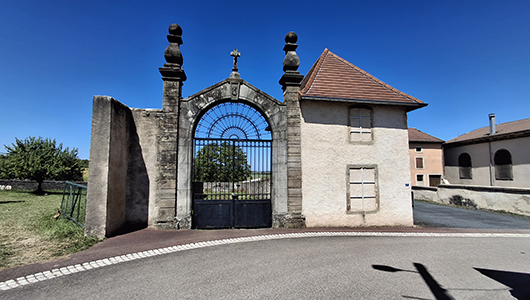Romont
Durée visite à pied : 20 minutes
Durée visite à vélo : 15 minutes
La première mention de Romont apparaît dans la vie de saint Dié. Celui-ci s’étant arrêté dans ce village avait, grâce à un miracle, aidé des charpentiers travaillant dans un sanctuaire en construction. L’histoire du prieuré qui suivit est peu renseignée. D’après le chroniqueur Jean de Bayon, qui écrivait au XIVe siècle, le prieuré de Romont aurait été créé au XIe siècle par Hugues, moine de l’abbaye de Moyenmoutier, à qui serait dû également les prieurés de Belval, de Léomont, de Xures et de Clermont. Mais le rôle de Hugues n’est en fait attesté qu’à Belval. En 1711, le prieuré de Romont appartient encore à la congrégation bénédictine de Saint-Vanne. C’est à Romont que vivaient au début du XVIIIe siècle les ancêtres de Frédéric Chopin, d’où la clef de sol dans les armoiries de la commune.
The first mention of Romont appears in the life of Saint Dié. He stopped in this village and, thanks to a miracle, helped some carpenters who could not use a beam that was too short in a sanctuary under construction. The history of the priory that followed is little known. According to the chronicler Jean de Bayon, who wrote in the 14th century, the priory of Romont was founded in the 11th century by Hugues, a monk of the Abbey of Moyenmoutier, to whom the priories of Belval, Léomont, Xures and Clermont are also said to have been founded. But Hugues’ role is actually only attested in Belval. In 1711, the priory of Romont still belonged to the Benedictine congregation of Saint-Vanne. It was in Romont that the ancestors of Frédéric Chopin lived at the beginning of the 18th century, hence the treble clef in the town’s coat of arms.
Die erste Erwähnung von Romont findet sich im Leben des Heiligen Dié. Er machte in diesem Dorf Halt und half dank eines Wunders einigen Zimmerleuten, die einen zu kurzen Balken in einem im Bau befindlichen Heiligtum nicht verwenden konnten. Über die Geschichte des darauf folgenden Priorats ist wenig bekannt. Laut dem Chronisten Jean de Bayon, der im 14. Jahrhundert schrieb, wurde das Priorat von Romont im 11. Jahrhundert von Hugues, einem Mönch der Abtei Moyenmoutier, gegründet, dem auch die Priorate Belval, Léomont, Xures und Clermont zugeschrieben werden. Doch Hugues’ Rolle ist eigentlich nur in Belval bezeugt. Im Jahr 1711 gehörte das Priorat von Romont noch zur Benediktinerkongregation von Saint-Vanne. In Romont lebten zu Beginn des 18. Jahrhunderts die Vorfahren von Frédéric Chopin, daher der Violinschlüssel im Wappen der Stadt.
wiederzubeleben.

D’azur au massacre de cerf d’argent, accompagné en chef d’une fleur de lys de même accostée de deux clefs de sol d’or.
Le massacre de cerf indique que le gibier est abondant à Romont. La fleur de lys rappelle les seigneurs du XIII° siècle. Enfin les clefs de sol nous indiquent que les ancêtres de Frédéric Chopin habitaient Romont.
Azure, a stag slaughter argent, accompanied in chief by a fleur-de-lis of the same flanked by two treble clefs or.
The stag slaughter indicates that game was abundant in Romont. The fleur-de-lis recalls the lords of the 13th century. Finally, the treble clefs indicate that Frédéric Chopin’s ancestors lived in Romont.
In Blau ein silberner Hirsch, obenauf eine Lilie desselben, flankiert von zwei Violinschlüsseln.
Der Hirsch zeigt, dass es in Romont reichlich Wild gab. Die Lilie erinnert an die Herren des 13. Jahrhunderts. Die Violinschlüssel deuten darauf hin, dass Frédéric Chopins Vorfahren in Romont lebten.

Les habitants de Romont s’appellent les Romontois et les Romontoises.
The inhabitants of Romont are called Romontois and Romontoises.
Die Einwohner von Romont heißen Romontois und Romontoises.
Les points de visites
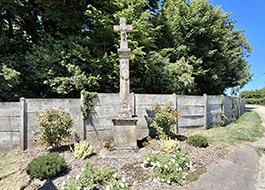
.
Les croix de chemins se sont multipliées à partir de 1095. A cette date, le droit d’asile est étendu à ces constructions. Elles ont alors un double rôle de guide et de protection. Ce droit diminua par la suite devant l’affermissement du pouvoir laïc.
Wayside crosses multiplied from 1095. At that time, the right of asylum was extended to these constructions. They then had a dual role of guide and protection. This right subsequently diminished in the face of the strengthening of secular power.
Ab 1095 nahmen die Wegkreuze zu. Damals wurde diesen Bauten das Asylrecht zuerkannt. Sie hatten dann die doppelte Funktion, Orientierung und Schutz zu bieten. Dieses Recht nahm später angesichts der Stärkung der weltlichen Macht ab.
.
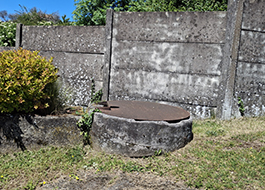
.
Romont comptait 625 habitants vers 1800. Le bourg était traversé par le ruisseau de la Grande-Prairie. Six fontaines, et deux puits permettaient aux villageois de puiser l’eau nécessaire aux usages quotidiens, et notamment aux besoins des animaux de ferme. Bovins et chevaux bénéficiaient en outre d’un guéoir. Celui-ci était relié au ruisseau par une vanne. Les animaux pouvaient y tremper leurs membres après les travaux des champs. Il servait également de réserve d’eau en cas d’incendie.
Romont had 625 inhabitants around 1800. The village was crossed by the Grande-Prairie stream. Six fountains and two wells allowed the villagers to draw the water necessary for daily needs, particularly for the needs of farm animals. Cattle and horses also benefited from a water well. This was connected to the stream by a valve. The animals could dip their limbs in it after working in the fields. It also served as a water reserve in case of fire.
Romont zählte um 1800 625 Einwohner. Das Dorf wurde vom Bach Grande-Prairie durchquert. Sechs Brunnen und zwei Brunnen ermöglichten den Dorfbewohnern die Wasserversorgung für den täglichen Bedarf, insbesondere für das Vieh. Auch Rinder und Pferde profitierten von einem Brunnen. Dieser war durch ein Ventil mit dem Bach verbunden. Die Tiere konnten nach der Feldarbeit ihre Beine darin eintauchen. Er diente auch als Wasserreserve im Brandfall.
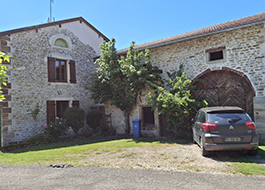
.
Cette maison bien restaurée appartenait jadis à des paysans, l’agriculture constituant l’essentiel des activités locales. En 1880, sur 1926 hectares de superficie territoriale, 739 étaient des terres labourables, 440 des prés, 20 destinés à la vigne, 514 des bois et 97 des jardins et des vergers. Les productions principales étaient le blé et la pomme de terre.
This well-restored house once belonged to farmers, with agriculture being the mainstay of local activity. In 1880, out of 1,926 hectares of land, 739 were arable land, 440 were meadows, 20 were used for vineyards, 514 were woods, and 97 were gardens and orchards. The main crops were wheat and potatoes.
Dieses gut restaurierte Haus gehörte einst Bauern, deren Hauptwirtschaftszweig die Landwirtschaft war. Im Jahr 1880 waren von den 1.926 Hektar Land 739 Ackerland, 440 Wiesen, 20 Weinberge, 514 Wälder und 97 Gärten und Obstgärten. Die Hauptanbaugebiete waren Weizen und Kartoffeln.
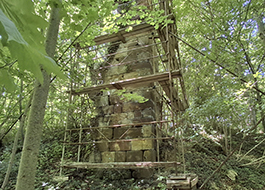
.
La propriété est privée ; de toutes façons, il ne reste de nos jours que quelques vestiges. Depuis longtemps disparu, le château de Romont était situé sur une éminence, à l’extrémité du village. En 1208, le duc de Lorraine Ferry Ier, par un traité avec son beau-père le comte Thiebault Ier de Bar, s’engagea à détruire le château et à ne le rétablir qu’avec l’accord du comte. Le traité ne fut apparemment pas suivi d’effet, puisqu’en en 1263, le duc Ferry II consentit à ce que le seigneur de Romont tînt, en fief et hommage du comte de Bar, le château donc toujours debout.
The property is private; in any case, only a few vestiges remain today. Romont Castle, long since lost, was located on a hill at the edge of the village. In 1208, the Duke of Lorraine Ferry I, by treaty with his father-in-law Count Thiebault I of Bar, agreed to destroy the castle and to only rebuild it with the Count’s agreement. The treaty was apparently not followed through, since in 1263, Duke Ferry II agreed that the Lord of Romont should hold the castle, which is still standing, as a fief and homage to the Count of Bar.
Das Anwesen ist in Privatbesitz, ohnehin sind heute nur noch wenige Überreste erhalten.
Die längst verlorene Burg Romont befand sich auf einem Hügel am Rande des Dorfes. 1208 einigte sich der Herzog von Lothringen Ferry I. in einem Vertrag mit seinem Schwiegervater Graf Thiebault I. von Bar darauf, die Burg zu zerstören und sie nur mit dessen Zustimmung wieder aufzubauen. Der Vertrag wurde offenbar nicht eingehalten, denn 1263 stimmte Herzog Ferry II. zu, dass der Herr von Romont die noch bestehende Burg als Lehen und Huldigung an den Grafen von Bar halten sollte.
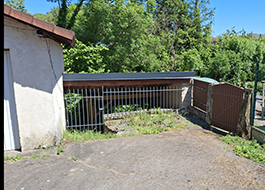
.
Cette fontaine, la plus ancienne de Romont, doit son nom à un disciple de saint Dié, au VIIIe siècle. Il était l’objet d’une grande dévotion. Saint Villigot était réputé guérir des maladies des yeux, pouvoir prêté à l’eau de cette fontaine. Pour éloigner les enfants de ce lieu un peu dangereux, on racontait qu’un esprit maléfique, Le Bonnet Rouge, y emportait les petits dans son antre aquatique.
This fountain, the oldest in Romont, owes its name to a disciple of Saint Dié in the 8th century. He was the object of great devotion. Saint Villigot was reputed to cure eye diseases, a power attributed to the water of this fountain. To keep children away from this somewhat dangerous place, it was said that an evil spirit, the Red Cap, carried the little ones into his aquatic lair.
Dieser Brunnen, der älteste in Romont, verdankt seinen Namen einem Schüler des Heiligen Dié im 8. Jahrhundert. Er war Gegenstand großer Verehrung. Dem Heiligen Villigot wurde die Fähigkeit nachgesagt, Augenkrankheiten zu heilen, eine Kraft, die dem Wasser dieses Brunnens zugeschrieben wurde. Um Kinder von diesem etwas gefährlichen Ort fernzuhalten, soll ein böser Geist, der Rotkäppchen, die Kleinen in seine Wasserhöhle getragen haben.

.
Il s’agit d’un édifice très sobre, sans décor hormis d’une croix. Ce qui, avec sa situation près de l’église, affirme son aspect religieux. D’autres communes ont opté pour des sujets plus laïcs, même si le substrat chrétien a pu transparaître, comme dans le cas d’une Marianne tenant un Poilu mort dans ces bras, reprise du thème de la piéta. La présence d’obus autour de l’obélisque indique, qu’au lendemain de la Grande Guerre, le pacifisme est encore très ténu. Il ne se développera que plus tard.
It is a very sober building, with no decoration except for a cross. This, along with its location near the church, affirms its religious aspect. Other municipalities have opted for more secular subjects, even if the Christian substratum has been able to shine through, as in the case of a Marianne holding a dead Poilu in her arms, a reprise of the theme of the Pietà. The presence of shells around the obelisk indicates that, in the aftermath of the Great War, pacifism was still very tenuous. It would only develop later.
Es ist ein sehr schlichtes Gebäude, das außer einem Kreuz keinerlei Verzierungen aufweist. Dies und seine Lage in der Nähe der Kirche unterstreichen seinen religiösen Charakter. Andere Gemeinden haben sich für weltlichere Motive entschieden, auch wenn das christliche Fundament durchscheinen konnte, wie beispielsweise bei einer Marianne, die einen toten Poilu in den Armen hält – eine Wiederholung des Themas der Pietà. Die Granaten rund um den Obelisken deuten darauf hin, dass der Pazifismus nach dem Ersten Weltkrieg noch sehr schwach war. Er entwickelte sich erst später.
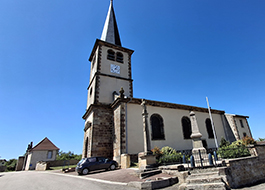
.
Elle date de 1803. Son orgue a été réalisé en 1878 par Jaquot-Jeanpierre. Cette firme fut la plus grande entreprise vosgienne de facture d’orgue au XIXe siècle. Elle eut des prolongements jusqu’à aujourd’hui avec la manufacture de grandes orgues de Rambervillers, berceau de cette entreprise familiale. Au Moyen Âge, le droit de collation de la paroisse appartenait au prieur du lieu ; il percevait les deux tiers de la dîme, l’autre tiers allant au curé.
It dates from 1803. Its organ was built in 1878 by Jaquot-Jeanpierre. This firm was the largest organ-building company in the Vosges in the 19th century. It continued to this day with the Vosges manufacture of great organs in Rambervillers, the cradle of this family business. In the Middle Ages, the right of collation of the parish belonged to the local prior; he received two-thirds of the tithe, the other third going to the priest.
Sie stammt aus dem Jahr 1803. Die Orgel wurde 1878 von Jaquot-Jeanpierre gebaut. Diese Firma war im 19. Jahrhundert die größte Orgelbaufirma der Vogesen. Bis heute wird in Rambervillers, der Wiege dieses Familienunternehmens, große Orgeln in den Vogesen gebaut. Im Mittelalter lag das Kollationsrecht der Gemeinde beim örtlichen Prior; er erhielt zwei Drittel des Zehnten, das andere Drittel ging an den Pfarrer.
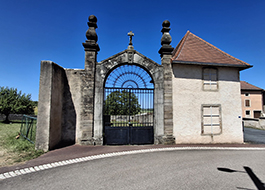
.
On ne peut manquer sa porte monumentale. Sur les 284 tombes, certaines contiennent les restes de villageois morts pour la France en 1914-1918. Immédiatement après la Première Guerre mondiale, les familles des soldats pouvaient faire transférer à leurs frais les corps des défunts, des cimetières militaires vers une sépulture familiale. Il existe aussi des carrés spéciaux comme à Moyemont.
Its monumental gate is unmissable. Of the 284 graves, some contain the remains of villagers who died for France in 1914-1918. Immediately after the First World War, soldiers’ families could have the bodies of the deceased transferred from military cemeteries to a family burial site at their own expense. There are also special plots, such as those at Moyemont.
Das monumentale Tor ist unübersehbar. Einige der 284 Gräber enthalten die Überreste von Dorfbewohnern, die zwischen 1914 und 1918 für Frankreich gefallen waren. Unmittelbar nach dem Ersten Weltkrieg konnten Soldatenfamilien die Leichen ihrer Verstorbenen auf eigene Kosten von Militärfriedhöfen in eine Familiengrabstätte überführen lassen. Es gibt auch spezielle Grabstätten, wie die in Moyemont.

